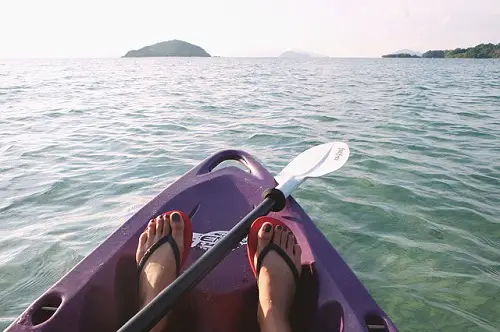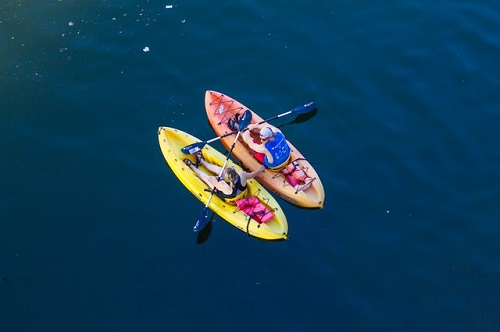If you want to have fun and avoid problems during your kayaking adventures, investing in the right gear is essential. Apart from the boat, paddle, and lifejacket, you also need proper clothing for this activity. When it comes to footwear around water, flip flops are a popular choice.
They are generally convenient, waterproof, comfortable, and easy to put on/off. I recently lost my wet shoes, so I wonder if wearing my flip flops to kayak is a good idea. Well, I’ve done some research and try it to understand if this type of footwear is appropriate for paddling sports!
Can I Wear Flip Flops Kayaking?
You can wear flip flops while kayaking, but it’s generally not recommended. They can slip off easily, it doesn’t protect your feet entirely, and their soles lack support/traction to provide stability on wet rocks. So water shoes/booties are more comfortable, safe, and appropriate than flip flops to kayak.

What footwear you will need while paddling depends on several factors. Flip flops can sometimes be an excellent option for kayaking. If you select the right pair and it’s suitable for the type of adventure you plan to do, there’s no problem wearing them in your boat.
However, flip flops aren’t the best things you can put on your feet to kayak. They aren’t well-suited for this activity, and it’s easy to notice while paddling in the water. If you want to make your paddling trips as enjoyable and safe as possible, investing in proper footwear is an excellent idea!
Why Should You Not Kayak Wearing Flip Flops?
Now that you know flip flops aren’t ideal to paddle in the water, it’s time to understand why. There are a few reasons you should avoid them. Here’s what’s wrong with flips flops when it comes to kayaking!
Open Footwear Won’t Protect Your Feet!
The purpose of wearing something on your feet is primarily to keep them away from harm. Well, lack of protection is inevitable if you wear something that’s only covering them partially. You might think paddling in your kayak doesn’t involve any danger.
But even if your lower body is practically immobile in the boat, it doesn’t mean your feet are safe. In an open kayak, they can be at risk of sunburns. Without appropriate shoes, you are also more likely to hurt yourself while walking on sharp rocks.
Flip Flops Are Slippery!
The traction offered by flip flop soles isn’t exceptional. It’s not only essential to prevent accidents on slippery surfaces near the water. You will also need enough grip to get in and out of the kayak or have more control over the boat.
You Can Find More Comfortable Footwear!
There’s nothing more annoying than doing sport wearing something uncomfortable. Flip flops might be suitable to paddle 5 minutes in a recreational kayak. However, the flimsy straps and the unsupportive sole isn’t the perfect construction to make your adventures in the water as fun and comfortable as possible.
The flip flop straps can lead to skin irritation or blisters. It’s another reason why they aren’t comfortable, especially for extended wear. So I’m sure that you will enjoy your adventures on the water more if you’re cozy in your boat.
What Are The Benefits Of Wearing Flip Flops While Kayaking?
Although flip flops aren’t the best option for your comfort and safety while paddling, they also have some advantages. Depending on your needs and the type of adventure you plan to do, this type of footwear might be suitable. Thus, here are some good reasons to wear flip flops while kayaking.
First, they will allow your feet to dry quickly. Water shoes generally stay wet for quite a bit of time, even in the sun. On the other hand, flip flops have an open design that’s easy and quick to dry.
Another advantage of this kayaking footwear is breathability. Because it doesn’t cover your feet totally, it means they can ventilate for a better experience while paddling. Wearing enclosed wet shoes isn’t always comfortable.
The last benefit of wearing flip flops to kayak is their convenience. You can put them on/off quickly, they are versatile footwear, and it’s easy to carry them. So putting flip flops on your feet while paddling has some positive sides, but it’s generally not the best option.
Pros & Cons Of Wearing Flip Flops To Kayak!
As you can see, this type of footwear has advantages as well as drawbacks. That’s why it can be complicated to understand if you should or not bring your flip flops on paddling adventures. Thus, here are the main points concerning what’s good and bad about them!
Pros:
- Dry Quickly.
- Easy To Put On/Off.
- Convenient To Carry.
- Versatile Footwear.
Cons:
- Not The Safest Option For Kayaking.
- Lack Of Protection.
- The Soles Don’t Offer Good Traction.
- Not Enough Support For Your Feet.
- They Come Off Easily.
Best Kayaking Footwear Alternative To Flip Flops!
Now, you know why flip flops aren’t what you should wear to make paddling as fun and safe as possible. So it’s time to start looking for another option more appropriate for kayaking. Your personal needs and preferences will also influence what type of footwear you should choose.
Water Shoes.
The ultimate alternative to cheap and uncomfortable flip flops is kayaking water shoes. It’s designed with a thick and slip-resistant sole to prevent injuries and accidents on wet rocky surfaces. But it’s still comfortable enough to be worn for long paddling adventures.
Some of them also have tiny holes on the sole to encourage water drainage and make the shoes dry faster. There are multiple designs available with different cut types, thickness, material construction, etc. Here are 3 of my favorite options on the market!
Best Overall Water Booties For Kayaking → NRS Paddle Wet Shoes
Best Versatile Kayaking Water Shoe → Merrell All Out Blaze Aero
Best Budget-Friendly Water Footwear → WateLves Quick-Dry Aqua Shoes
Here’s more information about the best kayaking shoes!
Can You Kayak Barefoot?
Although it’s generally not recommended, you can kayak barefoot. Some paddlers might feel more comfortable and confident without footwear, but it’s not the safest option. Water shoes are always the best way to avoid injuries, accidents, and diseases.
With all the times I’ve hurt myself in a river or ocean, it’s now a no-brainer for me to wear something on my feet while kayaking. If you’re ready to take more risks by paddling barefoot, there’s no problem. Just be aware of the dangers to which you’re exposed.
What Should You Wear In Your Feet To Kayak?
Most of the time, staying barefoot or putting flip flops on is not the smartest move when you head out in the water. On the other hand, water shoes are generally the best type of kayaking footwear.
Compared to most other alternatives, they will keep your feet safe and provide them with optimal comfort. But there are several designs out there from which you can choose.
Things To Consider In Kayaking Footwear!
Water shoes aren’t better than flip flops to go paddling for no reason. Some features make them more appropriate for this sport. Therefore, here are a few elements to look at if you want to find the perfect footwear to kayak in the water.
Material.
Water shoes are the most suitable for kayaking mainly because of their neoprene construction. This material traps a thin layer of water between the boot and the foot to act as a wet suit. Neoprene water shoes use the body heat from your feet to keep them warm.
It’s also a very flexible, comfortable, and lightweight material. That’s why it’s so convenient for paddling adventures. In addition to neoprene, some water booties have titanium to make them more performant and durable.
For the soles of kayaking footwear, you need something that offers proper support and traction. It should also be solid and comfortable enough for walking on rocks safely. So the soles of most water shoes are made from rubber to provide optimal grip and protection.
Comfort.
Another essential factor to consider in footwear is comfortability. If you don’t feel good in your kayak gear, paddling won’t be as enjoyable as it could be. The material, breathability, fit, and many other elements can influence how comfy water shoes are.
Size/Design.
The dimensions are also an essential factor to consider, especially for kayaking footwear. In general, there are three principal heights of water shoes for this sport: Low-Cut, Ankle-Cut & Knee-High. Here’s what the difference is and how to know which design you should choose.
Low-Cut: Low-cut water shoes only protect your feet and stop under the ankle. They are small, comfortable, and sometimes have a breathable mesh. Although it doesn’t offer as much protection as other designs, it’s still an excellent option to paddle in hot conditions.
Ankle-Cut: Ankle-cut kayak boots go slightly over the ankle to protect more than just your feet. They are also warmer and offer more support. It’s my favorite height because this type of footwear design is highly versatile, comfortable, and protective.
Knee-High: Knee-high water shoes almost protect your whole legs. They are the warmest and offer the ultimate protection for kayaking. So it’s an ideal design for keeping you safe in cold weather.
Breathability.
Investing in warm neoprene booties might not be the ideal solution if you plan to paddle in a hot environment. Their design is likely to make your feet sweat which can lead to bacteria development and unpleasant odor. If you’re looking for breathable kayaking footwear, consider Gore-Tex or low-cut water shoes.
Other Conditions To Keep In Mind!
Apart from the water shoe features, you can also consider other external factors. Even with the best kayaking footwear, it’s useless if not appropriate for your needs. Therefore, here are a few more aspects to keep in mind during your shopping.
Water Environment.
The place where you want to launch your kayak is an essential factor to know. You won’t need the same type of footwear to start on a beach as you would on sharp and wet rocks. Wearing flip flops might be OK if you find an appropriate environment to access the water with them on your feet.
Type Of Kayak.
Your boat design can also highly influence what you should be looking for covering your feet. For example, my freestyle river kayak is so tight that wearing huge water shoes would not be possible nor comfortable. That’s why you need to select footwear according to the kayak you ride in.
Weather.
Another essential condition to consider is the temperature. Whether it’s cold or hot outside, you should always wear shoes in consequence. Flip flops won’t keep your feet warm, but they are excellent for extreme heat.
Personal Needs & Preferences.
Finally, you also have your word to say. Don’t forget who is going to wear the water shoes. If you want a specific color, feature, or price, go for it. Just make sure the kayaking footwear you choose is still appropriate for your needs.
Last Thoughts About Kayaking With Flip Flops!
When it comes to waterproof footwear, you have a lot of options available on the market. Flip flops are one of them, and they are versatile, convenient, and quick to dry. But for kayaking, it’s generally not recommended because they lack protection, traction, and support.

Instead of flip flops, you should invest in water shoes appropriate for this water sport. Otherwise, your paddling adventures won’t be as safe and enjoyable as they can be.
I hope my article has helped you understand what type of footwear you should have to kayak. Now it’s time to gear up properly and get ready to head out on the water!
